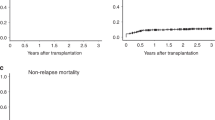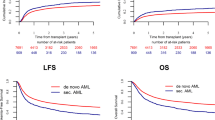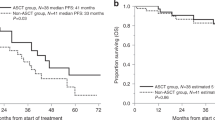Abstract
Allogeneic stem cell transplantation (SCT) remains the best curative option for patients with refractory AML or with high-risk myelodysplastic syndrome (MDS). For decades, age alone had been widely used as the primary criterion to assess eligibility for allogeneic SCT; however, prospective studies to evaluate allogeneic SCT in elderly patients are still limited. A total of 187 patients (median age of 64 years, range 60–77 years) with AML (87%) or MDS (13%) transplanted between 1999 and 2014 were included in this retrospective analysis. Relapse-free survival (RFS) and overall survival (OS) at 3 years were 32% (95% confidence interval (CI): 25–39%) and 35% (95%CI: 27–42%), respectively. Overall survival was 49% (95%CI: 35–64%) in AML patients who were transplanted in first complete remission (CR1), but even patients with active disease did benefit from transplantation, showing an OS at 3 years of 30% (95%CI: 20-40%). Multivariate analysis revealed disease- and patient-specific risk indices as independent prognostic factors for OS and non-relapse mortality (NRM). In conclusion, our monocenter results indicate that patients should not be generally withheld from allogeneic SCT because of age or disease status only. Specific risk models incorporating disease status and disease-specific risk factors at the time of transplantation as well as existing comorbidities are helpful tools to assess transplantation-associated risk factors of elderly patients.
This is a preview of subscription content, access via your institution
Access options
Subscribe to this journal
Receive 12 print issues and online access
$259.00 per year
only $21.58 per issue
Buy this article
- Purchase on Springer Link
- Instant access to full article PDF
Prices may be subject to local taxes which are calculated during checkout


Similar content being viewed by others
References
Stelljes M, Krug U, Beelen DW, Braess J, Sauerland MC, Heinecke A et al. Allogeneic transplantation versus chemotherapy as postremission therapy for acute myeloid leukemia: a prospective matched pairs analysis. J Clin Oncol 2014; 32: 288–296.
Mufti GJ, Potter V . Myelodysplastic syndromes: who and when in the course of disease to transplant. Hematology Am Soc Hematol Educ Program 2012; 2012: 49–55.
Vyas P, Appelbaum FR, Craddock C . Allogeneic hematopoietic cell transplantation for acute myeloid leukemia. Biol Blood Marrow Transplant 2015; 21: 8–15.
Armand P, Gibson CJ, Cutler C, Ho VT, Koreth J, Alyea EP et al. A disease risk index for patients undergoing allogeneic stem cell transplantation. Blood 2012; 120: 905–913.
Devine SM, Owzar K, Blum W, Mulkey F, Stone RM, Hsu JW et al. Phase II study of allogeneic transplantation for older patients with acute myeloid leukemia in first complete remission using a reduced-intensity conditioning regimen: results from cancer and leukemia group B 100103 (Alliance for Clinical Trials in Oncology)/Blood and Marrow Transplant Clinical Trial Network 0502. J Clin Oncol 2015; 33: 4167–4175.
Sorror ML, Storb RF, Sandmaier BM, Maziarz RT, Pulsipher MA, Maris MB et al. Comorbidity-age index: a clinical measure of biologic age before allogeneic hematopoietic cell transplantation. J Clin Oncol 2014; 32: 3249–3256.
Sorror ML, Maris MB, Storb R, Baron F, Sandmaier BM, Maloney DG et al. Hematopoietic cell transplantation (HCT)-specific comorbidity index: a new tool for risk assessment before allogeneic HCT. Blood 2005; 106: 2912–2919.
Gratwohl A, Stern M, Brand R, Apperley J, Baldomero H, de Witte T et al. Risk score for outcome after allogeneic hematopoietic stem cell transplantation: a retrospective analysis. Cancer 2009; 115: 4715–4726.
Armand P, Kim HT, Logan BR, Wang Z, Alyea EP, Kalaycio ME et al. Validation and refinement of the Disease Risk Index for allogeneic stem cell transplantation. Blood 2014; 123: 3664–3671.
Buchner T, Berdel WE, Schoch C, Haferlach T, Serve HL, Kienast J et al. Double induction containing either two courses or one course of high-dose cytarabine plus mitoxantrone and postremission therapy by either autologous stem-cell transplantation or by prolonged maintenance for acute myeloid leukemia. J Clin Oncol 2006; 24: 2480–2489.
Buchner T, Berdel WE, Haferlach C, Haferlach T, Schnittger S, Muller-Tidow C et al. Age-related risk profile and chemotherapy dose response in acute myeloid leukemia: a study by the German Acute Myeloid Leukemia Cooperative Group. J Clin Oncol 2009; 27: 61–69.
Gratwohl A . The EBMT risk score. Bone Marrow Transplant 2012; 47: 749–756.
Gratwohl A, Hermans J, Goldman JM, Arcese W, Carreras E, Devergie A et al. Risk assessment for patients with chronic myeloid leukaemia before allogeneic blood or marrow transplantation. Chronic Leukemia Working Party of the European Group for Blood and Marrow Transplantation. Lancet 1998; 352: 1087–1092.
Sorror ML, Sandmaier BM, Storer BE, Franke GN, Laport GG, Chauncey TR et al. Long-term outcomes among older patients following nonmyeloablative conditioning and allogeneic hematopoietic cell transplantation for advanced hematologic malignancies. JAMA 2011; 306: 1874–1883.
Krauter J, Wagner K, Stadler M, Dammann E, Zucknick M, Eder M et al. Prognostic factors in allo-SCT of elderly patients with AML. Bone Marrow Transplant 2011; 46: 545–551.
McClune BL, Weisdorf DJ, Pedersen TL, Tunes da Silva G, Tallman MS, Sierra J et al. Effect of age on outcome of reduced-intensity hematopoietic cell transplantation for older patients with acute myeloid leukemia in first complete remission or with myelodysplastic syndrome. J Clin Oncol 2010; 28: 1878–1887.
Schetelig J, Bornhauser M, Schmid C, Hertenstein B, Schwerdtfeger R, Martin H et al. Matched unrelated or matched sibling donors result in comparable survival after allogeneic stem-cell transplantation in elderly patients with acute myeloid leukemia: a report from the cooperative German Transplant Study Group. J Clin Oncol 2008; 26: 5183–5191.
Shapira MY, Tsirigotis P, Resnick IB, Or R, Abdul-Hai A, Slavin S . Allogeneic hematopoietic stem cell transplantation in the elderly. Crit Rev Oncol Hematol 2007; 64: 49–63.
Kollman C, Spellman SR, Zhang MJ, Hassebroek A, Anasetti C, Antin JH et al. The effect of donor characteristics on survival after unrelated donor transplantation for hematologic malignancy. Blood 2015; 127: 260–267.
Elmaagacli AH, Steckel NK, Koldehoff M, Hegerfeldt Y, Trenschel R, Ditschkowski M et al. Early human cytomegalovirus replication after transplantation is associated with a decreased relapse risk: evidence for a putative virus-versus-leukemia effect in acute myeloid leukemia patients. Blood 2011; 118: 1402–1412.
Lee SJ, Klein J, Haagenson M, Baxter-Lowe LA, Confer DL, Eapen M et al. High-resolution donor-recipient HLA matching contributes to the success of unrelated donor marrow transplantation. Blood 2007; 110: 4576–4583.
Schmidt-Hieber M, Labopin M, Beelen D, Volin L, Ehninger G, Finke J et al. CMV serostatus still has an important prognostic impact in de novo acute leukemia patients after allogeneic stem cell transplantation: a report from the Acute Leukemia Working Party of EBMT. Blood 2013; 122: 3359–3364.
Mariotti J, Maura F, Spina F, Roncari L, Dodero A, Farina L et al. Impact of cytomegalovirus replication and cytomegalovirus serostatus on the outcome of patients with B cell lymphoma after allogeneic stem cell transplantation. Biol Blood Marrow Transplant 2014; 20: 885–890.
El-Cheikh J, Devillier R, Crocchiolo R, Furst S, Calmels B, Faucher C et al. Impact of pretransplant donor and recipient cytomegalovirus serostatus on outcome for multiple myeloma patients undergoing reduced intensity conditioning allogeneic stem cell transplantation. Mediterr J Hematol Infect Dis 2013; 5: e2013026.
Green ML, Leisenring WM, Xie H, Walter RB, Mielcarek M, Sandmaier BM et al. CMV reactivation after allogeneic HCT and relapse risk: evidence for early protection in acute myeloid leukemia. Blood 2013; 122: 1316–1324.
Erker CG, Steins MB, Fischer RJ, Kienast J, Berdel WE, Sibrowski W et al. The influence of blood group differences in allogeneic hematopoietic peripheral blood progenitor cell transplantation. Transfusion 2005; 45: 1382–1390.
Sorror ML . How I assess comorbidities before hematopoietic cell transplantation. Blood 2013; 121: 2854–2863.
Shouval R, Labopin M, Bondi O, Mishan-Shamay H, Shimoni A, Ciceri F et al. Prediction of allogeneic hematopoietic stem-cell transplantation mortality 100 days after transplantation using a machine learning algorithm: a European Group for Blood and Marrow Transplantation Acute Leukemia Working Party Retrospective Data Mining Study. J Clin Oncol 2015; 33: 3144–3151.
Scott B, Pasquini M, Logan B, Wu J, Devine S, Porter DL et al. Results of a phase III randomized, multi-center study of allogeneic stem cell transplantation after high versus reduced intensity conditioning in patients with myelodysplastic syndrome (MDS) or acute myeloid leukemia (AML): Blood and Marrow Transplant Clinical Trials Network (BMT CTN) 0901. Blood 2015; 126: LBA-8.
Author information
Authors and Affiliations
Corresponding author
Ethics declarations
Competing interests
The authors declare no conflict of interest.
Additional information
Presented in part at the 57th Annual Meeting of the American Society of Hematology, December, 2015, Orlando, FL.
Rights and permissions
About this article
Cite this article
Pohlen, M., Groth, C., Sauer, T. et al. Outcome of allogeneic stem cell transplantation for AML and myelodysplastic syndrome in elderly patients (⩾60 years). Bone Marrow Transplant 51, 1441–1448 (2016). https://doi.org/10.1038/bmt.2016.156
Received:
Revised:
Accepted:
Published:
Issue Date:
DOI: https://doi.org/10.1038/bmt.2016.156
This article is cited by
-
Impact of age on hospitalization and outcomes post allogeneic hematopoietic cell transplantation outcome, a single center experience
Annals of Hematology (2023)
-
Allogeneic hematopoietic stem cell transplantation remains a feasible approach for elderly with acute myeloid leukemia: a 10-year experience
Annals of Hematology (2023)
-
Outcomes of two-step haploidentical allogeneic stem cell transplantation in elderly patients with hematologic malignancies
Bone Marrow Transplantation (2022)
-
Age is no barrier for adults undergoing HCT for AML in CR1: contemporary CIBMTR analysis
Bone Marrow Transplantation (2022)
-
Increased opportunity for prolonged survival after allogeneic hematopoietic stem cell transplantation in patients aged 60–69 years with myelodysplastic syndrome
Annals of Hematology (2019)



